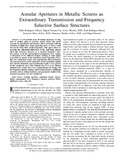Mostrar el registro sencillo del ítem
Annular apertures in metallic screens as extraordinary transmission and frequency selective surface structures
| dc.creator | Rodríguez Ulibarri, Pablo | es_ES |
| dc.creator | Navarro Cía, Miguel | es_ES |
| dc.creator | Rodríguez Berral, Raúl | es_ES |
| dc.creator | Mesa, Francisco | es_ES |
| dc.creator | Medina, Francisco | es_ES |
| dc.creator | Beruete Díaz, Miguel | es_ES |
| dc.date.accessioned | 2017-12-15T14:27:52Z | |
| dc.date.available | 2017-12-15T14:27:52Z | |
| dc.date.issued | 2017 | |
| dc.identifier.citation | Annular Apertures in Metallic Screens as Extraordinary Transmission and Frequency Selective Surface Structures. (2017). IEEE Transactions on Microwave Theory and Techniques, Microwave Theory and Techniques, IEEE Transactions on, IEEE Trans. Microwave Theory Techn, (12), 4933. doi:10.1109/TMTT.2017.2732985 | en |
| dc.identifier.issn | 0018-9480 | |
| dc.identifier.uri | https://hdl.handle.net/2454/26588 | |
| dc.description.abstract | A 2-D periodic array of annular apertures (or ring slots) is studied using an accurate circuit model. The model accounts for distributed and dynamic effects associated with the excitation of high-order modes operating above or below cutoff but not far from their cutoff frequencies. This paper allows to ascertain the substantial differences of the underlying physics when this structure operates as a classical frequency selective surface or in the extraordinary-transmission (ET) regime. A discussion of two different designs working at each regime is provided by means of the equivalent circuit approach (ECA), full wave simulation results, and experimental characterization. The agreement between the equivalent circuit calculation applied here and the simulation and experimental results is very good in all the considered cases. This validates the ECA as an efficient minimal-order model and a low computational-cost design tool for frequency selective surfaces and ET-based devices. Additional scenarios such as oblique incidence and parametric studies of the structural geometry are also considered. | en |
| dc.description.sponsorship | This work was supported in part by the Spanish Ministerio de Economía y Competitividad with the European Union FEDER funds under Project TEC2013-41913-P and Project TEC2014-51902-C2-2-R and in part by the Spanish Junta de Andalucía under Project P12-TIC-1435. The work of P. Rodríguez-Ulibarri was supported by the Universidad Pública de Navarra under a Pre-Doctoral Scholarship. The work of M. Navarro Cía was supported by the University of Birmingham under the Birmingham Fellowship | en |
| dc.format.mimetype | application/pdf | en |
| dc.language.iso | eng | en |
| dc.publisher | IEEE | en |
| dc.relation.ispartof | IEEE Transactions on Microwave Theory and Techniques, Vol. 65, n. 12, December 2017 | es_ES |
| dc.rights | © 2017 IEEE. Personal use of this material is permitted. Permission from IEEE must be obtained for all other uses, in any current or future media, including reprinting/republishing this material for advertising or promotional purposes, creating new collective works, for resale or redistribution to servers or lists, or reuse of any copyrighted component of this work in other works | en |
| dc.subject | Annular aperture | en |
| dc.subject | Equivalent circuit | en |
| dc.subject | Extraordinary transmission (ET) | en |
| dc.subject | Frequency selective surfaces (FSSs) | en |
| dc.subject | Millimeter waves | en |
| dc.subject | Ring slot | en |
| dc.title | Annular apertures in metallic screens as extraordinary transmission and frequency selective surface structures | en |
| dc.type | Artículo / Artikulua | es |
| dc.type | info:eu-repo/semantics/article | en |
| dc.contributor.department | Ingeniería Eléctrica y Electrónica | es_ES |
| dc.contributor.department | Ingeniaritza Elektrikoa eta Elektronikoa | eu |
| dc.rights.accessRights | Acceso abierto / Sarbide irekia | es |
| dc.rights.accessRights | info:eu-repo/semantics/openAccess | en |
| dc.identifier.doi | 10.1109/TMTT.2017.2732985 | |
| dc.relation.projectID | info:eu-repo/grantAgreement/MINECO//TEC2013-41913-P/ES/ | en |
| dc.relation.projectID | info:eu-repo/grantAgreement/MINECO//TEC2014-51902-C2-2-R/ES/ | en |
| dc.relation.publisherversion | https://doi.org/10.1109/TMTT.2017.2732985 | |
| dc.type.version | Versión aceptada / Onetsi den bertsioa | es |
| dc.type.version | info:eu-repo/semantics/acceptedVersion | en |


